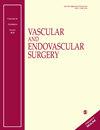Bow Hunter Phenomenon From Advanced Cerebrovascular Disease Treated With Subclavian Artery Stenting and Carotid Endarterectomy
IF 0.7
4区 医学
Q4 PERIPHERAL VASCULAR DISEASE
引用次数: 0
Abstract
Bow Hunter syndrome (BHS) is a rare disorder characterized by mechanical occlusion of the vertebral artery (VA) during neck rotation, resulting in symptomatic, transient, and positional vertebrobasilar insufficiency. We describe a case of a 76-year-old female who presented with dizziness and right ear tinnitus triggered by right head rotation. Her symptoms would immediately resolve upon returning her head to the neutral position. CT angiogram showed 80% stenosis of the left subclavian artery origin, 50%–70% stenosis of the proximal right internal carotid artery (ICA), and near occlusive stenoses of the origins of the bilateral VAs. After failing conservative management, the patient was treated with left subclavian artery stenting, followed by a right carotid endarterectomy (CEA) 6 weeks later. Follow-up at 1 month showed resolution of paroxysmal symptoms and no neurological sequelae. To our knowledge, there have not yet been reported cases of patients with concurrent BHS, subclavian artery stenosis, and carotid artery stenosis. We suggest that global revascularization via subclavian artery stenting and CEA may be considered as treatment for patients with BHS complicated by other cerebrovascular disease secondary to stenoses of the ICA and subclavian artery. This approach obviates the need for more complex surgery or endovascular intervention of the VA.锁骨下动脉支架植入术和颈动脉内膜剥脱术治疗晚期脑血管病的猎弓者现象
鲍-亨特综合征(BHS)是一种罕见的疾病,其特征是颈部旋转时椎动脉(VA)发生机械性闭塞,导致症状性、短暂性和位置性椎基底动脉供血不足。我们描述了一例 76 岁女性的病例,她在右侧头部旋转时出现头晕和右耳耳鸣。当她的头部恢复中立位时,症状会立即缓解。CT 血管造影显示左侧锁骨下动脉起源处狭窄 80%,右侧颈内动脉(ICA)近端狭窄 50%-70%,双侧 VAs 起源处近乎闭塞性狭窄。保守治疗无效后,患者接受了左锁骨下动脉支架植入术,6周后又接受了右颈动脉内膜剥脱术(CEA)。1 个月后的随访显示,阵发性症状缓解,没有神经系统后遗症。据我们所知,目前还没有关于患者同时患有 BHS、锁骨下动脉狭窄和颈动脉狭窄的病例报道。我们建议,对于因 ICA 和锁骨下动脉狭窄而并发其他脑血管疾病的 BHS 患者,可以考虑通过锁骨下动脉支架植入术和 CEA 进行全面血管重建。这种方法避免了对 VA 进行更复杂的手术或血管内介入治疗。
本文章由计算机程序翻译,如有差异,请以英文原文为准。
求助全文
约1分钟内获得全文
求助全文
来源期刊

Vascular and Endovascular Surgery
SURGERY-PERIPHERAL VASCULAR DISEASE
CiteScore
1.70
自引率
11.10%
发文量
132
审稿时长
4-8 weeks
期刊介绍:
Vascular and Endovascular Surgery (VES) is a peer-reviewed journal that publishes information to guide vascular specialists in endovascular, surgical, and medical treatment of vascular disease. VES contains original scientific articles on vascular intervention, including new endovascular therapies for peripheral artery, aneurysm, carotid, and venous conditions. This journal is a member of the Committee on Publication Ethics (COPE).
 求助内容:
求助内容: 应助结果提醒方式:
应助结果提醒方式:


